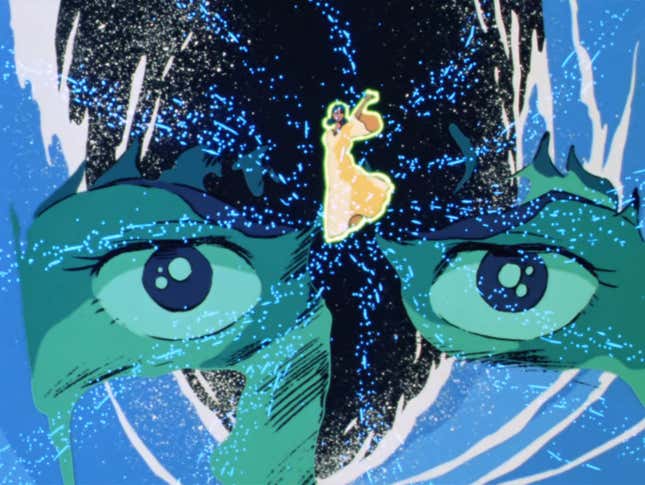This past weekend The Witch From Mercury brought a surprisingly rapid-fire end to the latest Gundam show—and in one of its most satisfying moves, finally delivered on the sapphic love story it set up from the get-go. But in truly making queer love the heart of its endgame, the series also pushed a closer examination of one of the franchise’s most enduring ideas.
That idea is a human evolutionary path known as the “Newtype.” First established in final arcs of the original Mobile Suit Gundam in 1979, the Newtype is a defining aspect of the franchise’s first and most explored timeline, the Universal Century: the next phase of human evolution and the representation of the highest potentials of interstellar civilization. Naturally occurring among the human population that has already adapted to life in space—people known as “Spacenoids” in the original Gundam, commonly referred to in Witch From Mercury’s own timeline worldbuilding as “Spacians”—Newtypes are human beings who have begun to develop empathetic psychic powers. This heightened spatial and sensory awareness not only makes them, as they are eventually exploited in doing so by “Oldtypes,” more effective pilots for enhanced Mobile Suits, but also capable of a fundamentally deeper understanding and connection to the people around them.
Advertisement

The Newtype as an idea came to represent the antithesis of Gundam’s generational mechanized conflicts, the ideal that humanity could achieve if it strove to better understand its disparate selves rather than deny them—and the inherent tragedy of when they are instead used as tools of war. And while Witch From Mercury itself as a non-Universal Century work has not explicitly used the Newtype concept in its own worldbuilding, it has played on the idea across its two seasons with its own parallel—a technological influence through a powerful mineral called Permet, and its corruption of the “Witches” that pilot Gundam-type Mobile Suits. From extrapolations on UC concepts like artificially-created enhanced pilots to the idea of the “Data Storm,” a post-body network of consciousness that could allow people to transcend this plane of reality and connect on a higher state of being, Witch From Mercury has offered its own take on the iconic hallmark of Gundam’s original works. But it’s also fittingly used them to explore the queer text it has also brought to the franchise’s forefront in the relationship between protagonist Suletta Mercury and her bride-to-be, Miorine Rembran.
Advertisement
Advertisement

“May All Blessings Find Their Way to You, I’m Wishing It,” Witch From Mercury’s final episode, made that relationship explicitly clear in its final act, establishing in a flash-foward to three years after the events of the series that Suletta and Miorine are now happily married—and that while Miorine is still grappling with the legacy of her father Delling and her own role in conflicts that came to pass between Earth and Space during the events of the series, Suletta herself is on the slow path to recovering from the toll of being a Gundam pilot.

That toll is enacted in the rest of the final episode, as we see Suletta surpass the physical limitations of the Gundam Calibarn’s unfiltered Permet systems to protect her mother and family—breaking through the Data Storm to not just control her own Gundam and every other surviving Gundam suit from the series, but to connect with the spirits of perished Gundam pilots from throughout the show. Using the power of the Gundams, Suletta unleashes a massive wave of Permet energy that shuts down the dual impending threats of Quiet Zero—her mother’s base of operations to usurp and control every Permet-utilizing system in the Earth Sphere—and the massive space laser threatening to blow it, and all of Suletta’s friends, up. But crucially above all, in doing so she dissipates the Gundams themselves, from her own suit to the Aerial that houses the Data Storm soul of her sister Eri, breaking them down at a molecular level so that their powers can never be used or exploited again. It’s an act of profound love, not just one for Suletta’s blood family, but the connections she has made over the course of the series, and most particularly her relationship with Miorine. It’s a greed, as Suletta describes it—she wants to spend time with the people she cares most about, and it’s also the ultimate expression of her love for, and desire to protect, Miorine.
Advertisement
It’s more than the fact that the color of Suletta’s Permet wave, both when she enhances her suit and the eventual halo that disables the Space Assembly League’s laser cannon, is a Technicolor rainbow, although that does help on a surface level in making things feel incredibly queer. The effect itself is akin to the Axis Shock of Char’s Counterattack—the moment when Gundam’s dueling Newtype protagonist and antagonist, Amuro and Char, ascended from their mortal forms while stopping an asteroid from slamming into Earth—further inviting the parallels between the Witches of Mercury and the Newtype concept. But in making the connection between Suletta and Miorine’s romantic love and the dismantling of a system that physically and existentially abused the despised “Witches” that piloted Gundams, The Witch From Mercury made explicit a queer reading of an idea in the franchise that has, on some level, long invited those readings among LGBTQ fans.
Advertisement
It is Suletta’s love for Miorine—a connection that is there for her even as the Calibarn dissolves around her—that ends the exploitative leash of the GUND format that powered the Gundams, and it’s a love that ends it not with an act of control or of violence, but in a her breaking free of the cycle of conflict the Gundams embodied. Suletta doesn’t immediately handwave all the problems Witch From Mercury’s world established. The flash-forward epilogue makes clear that the disparate inequalities between people on Earth and people in space are still being worked out, and while Gundams themselves may be gone there are ways to explore the technology that powered them as medical tools to help humanity ascend to the stars, rather than tear each itself apart. But Suletta at least seemingly does what even most Universal Century Gundam fiction could not yet achieve in freeing herself and her fellow GUND format users from the systems that exploited and persecuted this enhanced evolutionary future for humanity.
Tying such a moment into one of the franchise’s first explicitly queer relationships, a relationship that drove the very heart of the show’s story and helped make Witch From Mercury one of the most successful anime of the moment, marks a watershed for Gundam at large. While fans might be disappointed Witch From Mercury’s ending denied moments like an onscreen kiss or wedding for its heroines—there’s always room for spinoff material to explore that some day—making the queer subtext of one of the entire franchise’s most fundamental sci-fi ideas text is an altogether more profoundly impactful moment.
Advertisement
Want more io9 news? Check out when to expect the latest Marvel, Star Wars, and Star Trek releases, what’s next for the DC Universe on film and TV, and everything you need to know about the future of Doctor Who.
Services Marketplace – Listings, Bookings & Reviews